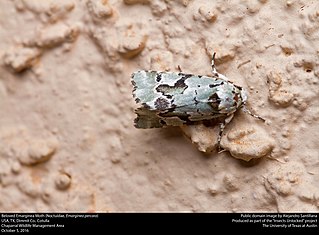
Apamea is a genus of moths in the family Noctuidae first described by Ferdinand Ochsenheimer in 1816.

Amphipyrinae is a subfamily of owlet moths in the family Noctuidae. There are more than 50 genera and 210 described species in Amphipyrinae, although the classifications are likely to change over time.

Cisseps is a genus of moths in the family Erebidae erected by John G. Franclemont in 1936.

The Xylenini are a mid-sized tribe of moths in the Hadeninae subfamily. There is some dispute about this tribe. Some resources have these genera listed under subfamily Cuculliinae instead, or upranked them to a distinct subfamily Xyleninae.

Abagrotis is a genus of moths of the family Noctuidae.

Anicla is a genus of moths of the family Noctuidae.

Chytonix is a genus of moths of the family Noctuidae.

Zale is a genus of moths in the family Erebidae erected by Jacob Hübner in 1818.

Eupsilia is a genus of moths of the family Noctuidae.

Leucania is a genus of moths of the family Noctuidae first described by Ferdinand Ochsenheimer in 1816.

Lithophane is a genus of moths of the family Noctuidae. They spend the winter as adults. Some species are capable of feeding on other caterpillars or on sawfly larvae, which is rather uncommon among Lepidoptera.

Matigramma is a genus of moths in the family Erebidae. The genus was erected by Augustus Radcliffe Grote in 1872.

Metaxaglaea is a genus of moths of the family Noctuidae.

Orthodes is a genus of moths of the family Noctuidae.
Pyreferra is a genus of moths of the family Noctuidae.

Neoligia is a genus of moths of the family Noctuidae. Most of the species where previously part of the semicana group of the genus Oligia.

Psaphidini is a tribe of owlet moths in the family Noctuidae. There are at least 40 genera and at least 90 described species in Psaphidini.
Pseudanarta caeca is a species of cutworm or dart moth in the family Noctuidae. It is found in North America.















